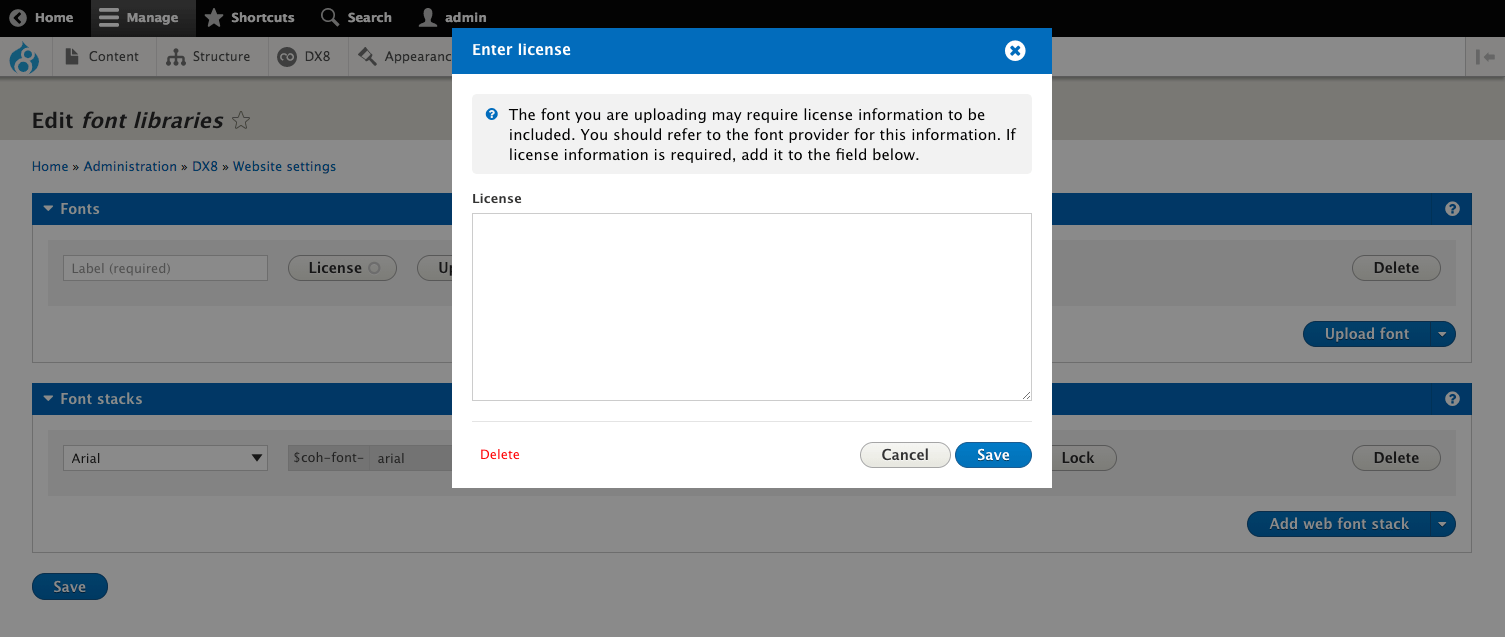Set up font libraries and font stacks
DX8 allows you to manage font libraries and font stacks used by your website. There are two steps to the process:
- Set up your font libraries
- Set up your font stacks
When setting up font libraries you have three options:
- Upload fonts. You can upload fonts to your website. When you upload a font it will be hosted with your website in the Cohesion directory. You must ensure that you have the appropriate licence to host and serve the font.
- Use web fonts. You can import fonts from web font providers like Google fonts. These fonts are hosted by the provider so all you need to do is add the URL of the font.
- Use system fonts. These are fonts that will usually be available on your users device so there's no need for you to provide the font. For example, Arial is a system font and the most widely supported. If using system fonts you can jump straight to Set up font your stacks as there are no fonts to upload or import.
Uploading or importing multiple web fonts will slow down your website loading speed. Only upload or import web fonts that you will use. Remove any fonts you are not using.
Upload fonts
To upload fonts:
- Navigate to DX8 > Website settings > Font libraries
- Enter a name in the Label field
- Click on the Upload.zip button and select your .zip file containing your prepared fonts. The .zip should include your font in EOT, TTF, WOFF and WOFF2 formats. Successfully uploaded font files will be marked with a green tick
- Click Save
When uploading a font package into DX8, please ensure you only have one instance of each font format (EOT, TTF, WOFF, WOFF2) included.
If your font supports multiple weights, you will need to import each of these as separate packages. You will also need to create separate font stacks for each weight.

To convert a font into EOT, TTF, WOFF and WOFF2 formats there are a number of online converters available.
https://transfonter.org
https://www.fontsquirrel.com/tools/webfont-generator
https://www.web-font-generator.com
Adding font license information
Many premium font providers (eg. fonts.com, typography.com) require licence information to be included with their CSS and a tracking script for page views. If a tracking script is required, this would need to be implemented in a custom theme.
To add license information:
- Upload a font, following the steps above
- Click the License button
- Paste in the font License information into the pop-up modal
- Click Save

Import web fonts
To import a web font:
- Click on the Blue button arrow and select Import font
- Enter a name in the Label field
- Enter the URL of the web font in the @import field. As an example, the URL should be formatted like this: https://fonts.googleapis.com/css?family=Poppins:300,400,600
- Click Save

If your font supports multiple weights, you will need to import each of these as separate packages. You will also need to create separate font stacks for each weight.
Set up your font stacks
Once you've uploaded or imported your fonts you need to set up your font stacks.
To set up your font stacks for imported or uploaded fonts (Highlighted with pink dashed line):
- Click on the blue button Add web font stack
- Enter a name in the Label field. You will use this name to identify and select your font throughout DX8
- Enter your font stack in the Font stack field. Your Font stack should be formatted like this: 'Poppins', sans-serif;
- If you want to apply font smoothing, Toggle on the Firefox and Webkit toggles
- Click Save
To set up a system font stack (Highlighted with blue dashed line):
- Click on the arrow on the blue button
- Click on Add system font stack
- A new system font stack row will be added to your form. DX8 provides drop down which includes different system font stacks
- In the drop-down click on the system font stack you want to add
- Click Save

When using DX8 sync to export font stacks or DX8 entities that have a dependency of a font stack such as a base style; the font library is not included as a dependency of font stacks and is therefore not included in the export file. If the font library is required, you can export it separately using DX8 sync.
Link/unlink font stack label
You can link or unlink the font stack label from the variable, this means that the label can be something different from the variable.
When adding a new font stack the label and variable fields are linked by default. This is shown by the link icon color being blue and the variable field is greyed out.
Note you can only change the font stack variable of a font stack that is not in-use.
To unlink a font stack label and variable:
- Navigate to DX8 > Website settings > Font libraries
- Click the link icon next to the label field
The variable field will turn white, if the font stack is not in-use - Update the font stack label
- Click Save.


